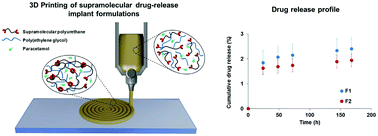A 3D printed drug delivery implant formed from a dynamic supramolecular polyurethane formulation†
Abstract
Using a novel molecular design approach, we have prepared a thermo-responsive supramolecular polyurethane as a matrix material for use in drug eluting implants. The dynamic supramolecular polyurethane (SPU) is able to self-assemble through hydrogen bonding and π–π stacking interactions, resulting in an addressable polymer network with a relatively low processing temperature. The mechanical properties of the SPU demonstrated the material was self-supporting, stiff, yet flexible thus making it suitable for hot-melt extrusion processing, inclusive of related 3D printing approaches. Cell-based toxicity assays revealed the SPU to be non-toxic and therefore a viable candidate as a biocompatible polymer for implant applications. To this end, the SPU was formulated with paracetamol (16% w/w) and 4 wt% or 8 wt% poly(ethylene glycol) (PEG) as an excipient and hot melt extruded at 100 °C to afford a 3D printed prototype implant to explore the extended drug release required for an implant and the potential manipulation of the release profile. Furthermore, rheological, infra-red spectroscopy, powder X-ray diffraction and scanning electron microscopy studies revealed the chemical and physical properties and compatibility of the formulation components. Successful release of paracetamol was achieved from in vitro dissolution studies and it was predicted that the drug would be released over a period of up to 8.5 months with hydrophilic PEG being able to influence the release rate. This extended release time is consistent with applications of this novel dynamic polymer as a drug eluting implant matrix.

- This article is part of the themed collection: Chemical Advances in Additive Manufacturing


 Please wait while we load your content...
Please wait while we load your content...